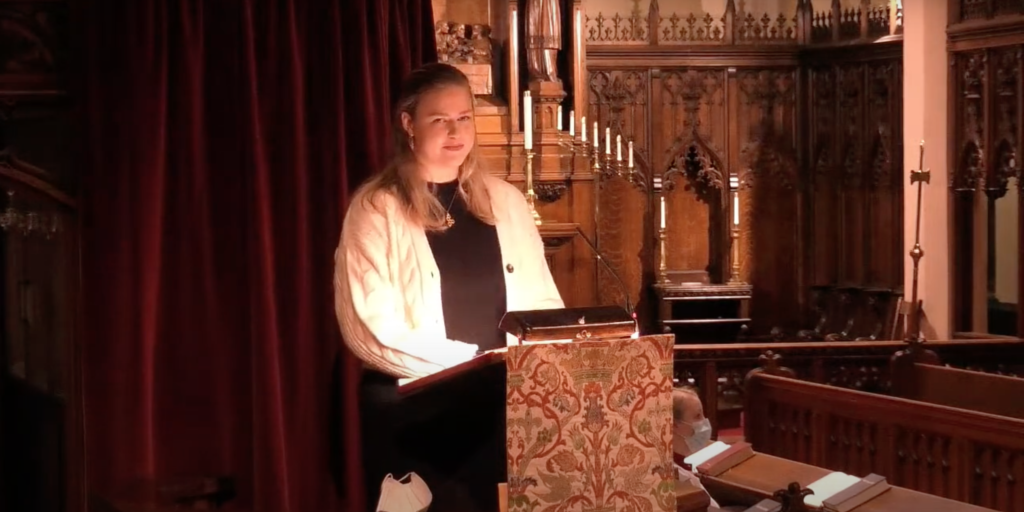Climate Stories: An Earth Day 2022 Reflection
Johannah shared this reflection at St. John the Evangelist Episcopal Church in St. Paul on April 24, 2022, for Earth Day Sunday. You can also listen here.
Finding our climate stories is how we sustain ourselves in the movement toward climate justice. Climate stories identify where our heart connects to the environment. Often a cherished memory from childhood, it could be from summer cabins running through the woods or gardening with a grandparent. It could be from losing a favorite natural place, or how you moved from apathy to activism. Something that planted a seed for your deep love for the Earth to grow.
At an Earth Day event on Friday, I was reminded by our song leader that facts don’t get people to care. Stories do. At this point, we all know and have maybe experienced at least some of the devastating realities of the climate crisis. From the rising temperatures and sea levels to intensified wildfires and drought, and all the lives threatened and lost in between. It is a lot to hold. But deeper than the sadness, fear, and anger that comes from these facts, is the fierce love we have for the environment. For our hearts’ connection to this home. Stories bring us together. Stories connect us to each other, to ourselves and to the Earth. And what’s something people of faith do really well? We tell stories.
My Climate Story
When I was a little girl, my mom and I would take a post-dinner bike ride every night to visit our favorite neighborhood tree. A magnificent weeping willow in the residential neighborhoods of Fort Lauderdale, Florida. My mom would pedal us to visit the fairy tree. Admiring her glory and all the abundant life she supported, we spent the early evenings in good company.
When we moved to Minnesota, I spent summers with my aunts up north. We would take pictures around the farm and go on hikes in the woods. The magic of nature, specifically of trees, brought my attention to the small details. I still stop to admire the little quirks and personalities of different trees and always pet the soft, spongy moss.
Though I feel a deep kinship with trees, it doesn’t take being a detail-oriented person to notice when tree-lined streets are suddenly bare. The company we’ve come to admire and rely on for shade and fresh air is no longer there. It is jarring to lose the protectiveness of a tree. I want to show up for the climate in fierce and consistent ways because it feels as imperative as showing up for a relative. The trees, birds, flowers eager to spring from the ground – are our relatives in the deepest sense because we are all deeply connected to each other.
How I continue to nurture my connection to the Earth
As I spend more time in the climate movement, I have found it even more imperative to find ways to reconnect with the Earth, to rekindle that spark of magic and deep love for the environment. For me, that continued nurturing has come in the form of open water swimming. A way to completely immerse myself in nature, to slow down and breathe. Notice the colors of the water around me, how it feels, smells, and sometimes tastes, an opportunity for meditation with nature.
To be with the trees and in the water are some of the ways I feel called to continued care for our shared home. To be connected in a way that allows for mutual support that requires we take care of one another. The way tree’s roots hold the soil together with branches outstretched and how the water heals and nurtures. Life supporting abundant life. The commitment to care helps bring me out of the grief and fear that often comes with the facts and experiences of the climate crisis. These feelings, though powerful, often lead to burnout and apathy when we need comfort and care. That is when I go back to the trees and into the water.
Find your climate story
Finding our climate story brings our hearts to the work, our compassion that allows us to tap into that story like a prayer and bring our love into reality. Our stories have power, especially when we realize that we are all connected to the Earth and to each other. When we take the time to slow down, to find and share our climate stories, we will not only be revitalized in the movement but be able to make effective, systemic, and long-lasting change together. We will move from cultures of extraction into cultures of care. We will see what a future with safe, liveable communities for everyone looks like and we will build it together. Our stories change the narrative from crisis to care.
As Jothsna Harris from Change Narrative has shared, we all have many climate stories and the process of uncovering one helps us to realize that there are many ways that we are connected.
So, what is your story?

